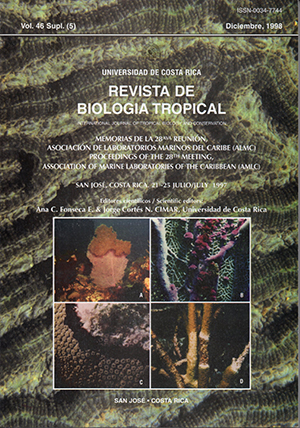Abstract
Novel pathologies of coral reef organisms, especially reef frame building scleractinian corals, have escalated during the decade between 1987 and 1997. These emerging diseases have appeared with progressively greater frequency and over wider distribution, and have revealed more diversified characteristics than ever before. The causes of most of these infections are no! ye! confirmed, but they evidence a gradual decline in the vital status of the coral reef ecosystem. As specific causes are identified for these afflictions, terminology will shift from non-specific descriptions, such as "white band", "white plague", "white pox", "yellow band" and "black band" diseases, to etiological and pathognomonic characterizations (e.g. aspergillosis and cyanobacteriosis). Stony corals are vulnerable to sedimentation, nutrient overloading, and chemical pollution from agricultural, urban, and domestic sources. They are incapable of relocation to other sites or of self-protection from cumulative effects of exposure to nitrates, phosphates, herbicides, pesticides, and raw sewage. In contrast to stresses attributed to warm water seasonal anomalies (e.g. coral reef bleaching), stresses imparted by pathogenic micro-organisms occur throughout !he calendar year, fluctuate with changing temperature, and invariably result in tissue mortality. The coral has several mechanisms for defense. The epidermis, especially in tentacles of !he coral polyp, contains nematocysts which are released in response to predators. The epidermal cells also possess cilia and a flagellary apparatus which are responsible for generating microcurrents in boundary water adjacent to the organism. These currents facilitate !he entry of food into !he coelenteron for digestion. Mesenterial filaments extend through !he epidermis, sweep !he surface of the colony, initiate digestion of food particles, and eventually return to the coelenteron. Bo!h the epidermis and the gastrodermis contain mucocytes (or "immunocytes") which release a mucous secretion. That mucous blanket physically insulates !he tissue from particulates or soluble toxins, and may also be bacteriostatic because of immunoglobulin (IgA). The recent emergence of diseases in corals may be interpreted as the consequence of (1) changing coastal ocean water quality favoring the proliferation, attachment and colonization of microbes, and (2) reduced efficiency of the coral's normal defenses. In order to appreciate these changes, research efforts to evaluate !he microbial content of reef waters and to analyze the respective roles of mucus, cilia and flagella, and nematocysts of !he corals are necessary. In this study, we have begun to detail the structural, physiological, chemical, and immunological attributes of!he coral. Our analysis suggests that at least some of the emerging coral diseases may be explained by a decline in the capacity of coral colonies to mount effective protection against !he increasing prevalence and varied invasive strategies of marine pathogens.##plugins.facebook.comentarios##

This work is licensed under a Creative Commons Attribution 4.0 International License.
Copyright (c) 1998 Revista de Biología Tropical
Downloads
Download data is not yet available.


